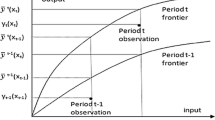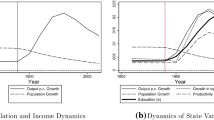Abstract
The literature on catching up suggests that due to diffusion and imitation, relatively backward countries should grow at a faster rate. A model along lines suggested by Abramovitz is constructed to examine this. A country's change in productivity (technological gap) is supposed to depend on the productivity gap itself (relatively backwardness), social capability of adopting new technology, and R&D-activity. Together with a vintage growth model, this set-up gives a lot of different possible explanations of why growth rates differ among nations. The possibilities of both catching up and falling behind are considered.
Similar content being viewed by others
References
Abramovitz M (1986) Catching up, forging ahead, and falling behind. J Econ Hist 46: 385–406
Barro R (1991) Economic growth in a cross sections of nations. Q J Econ 116: 407–443
Baumol W (1986) Productivity growth, convergence and welfare. What the long-run data show. Am Econ Rev 76: 1072–1085
Cohen W, Levinthal D (1989) Innovation and Learning. The two faces of R&D. Econ J 99: 569–596
Cornwall J (1977) Modern capitalism, its growth and transformation. Martin Bobertson, London
De Long J (1988) Productivity growth, convergence and welfare: comment. Am Econ Rev 78: 1138–1154
Dowrick S, Ngyen D (1989) OECD comparative growth 1950–85: catch-up and convergence. Am Econ Rev 79: 1010–1030
Fagerberg J (1988) Why growth rates differ. In: Dosi G et al: Technical Change and Economic Theory. Pinter Publishers, London
Gomulka S (1971) Inventive activity, diffusion and stages of economic growth. Mimeo Aarhus University
Johansen L (1959) Substitution versus fixed production coefficients in the theory of economic growth: a synthesis. Econometrica 27: 157–176
Maddison A (1982) Phases of capitalist development. Oxford University Press, Oxford
Mankiw G, Romer D, Weil D (1992) A contribution to the empirics of economic growth. Q J Econ 107: 407–437
Nelson R, Phelps E (1966) Investment in humans, technological diffusion, and economic growth. Am Econ Rev (Paper and Proceedings) 56: 69–75
Verspagen B (1991) A new empirical approach to catching up and falling behind. Struct Change Econ Dynam 2: 359–380
Wolff E (1991) Capital formation and productivity convergence over the long term. Am Econ Rev 81:565–579
Author information
Authors and Affiliations
Rights and permissions
About this article
Cite this article
Skonhoft, A. Catching up and falling behind, a vintage model approach. J Evol Econ 5, 285–295 (1995). https://doi.org/10.1007/BF01198308
Issue Date:
DOI: https://doi.org/10.1007/BF01198308




